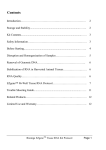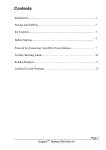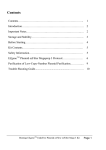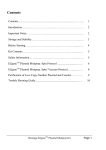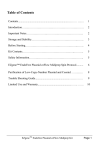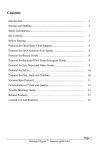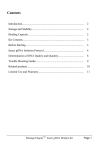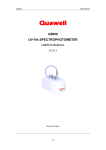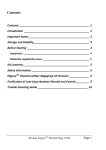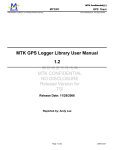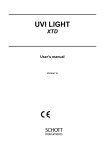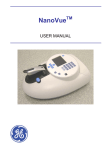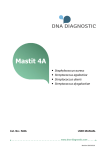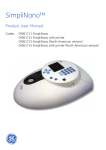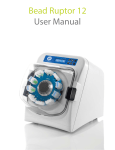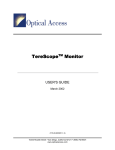Download 96 Well RNA Isolation Kit
Transcript
BIOMIGA The Inventor of EZgene TM Plasmid Purification System 96 Well RNA Isolation Kit R6811 Handbook VER 2013.06 Biomiga, Inc. 10637 Roselle Street, Suite C San Diego, CA 92121 Tel: (858) 597-0602 Fax: (858) 538-1698 Email: [email protected] For in vitro research use only Visit our web at www.biomiga.com and learn more about Biomiga products. If crystals form in buffers, warm up at 37°C to dissolve before use Limited Use and Warranty Related Products Catalog # Product Name Preps Price $ This product is intended for in vitro research use only. Not for use in human. R6311-01 Tissue RNA kit 50 150.00 This product is warranted to perform as described in its labeling and in Biomiga’s R6311-02 Tissue RNA kit 250 650.00 literature when used in accordance with instructions. No other warranties of any R1011-01 RNASecure Solution 50 mL 45.00 kind, express or implied, including, without limitation, implied warranties of R1011-02 RNASecure Solution 250 mL 150.00 10 80.00 merchantability or fitness for a particular purpose, are provided by Biomiga. Biomiga’s sole obligation and purchaser’s exclusive remedy for breach of this R6312-01 Tissue RNA midi kit warranty shall be, at the option of Biomiga, to replace the products, Biomiga shall R6312-02 Tissue RNA midi kit 20 160.00 have no liability for any direct, indirect, consequential, or incidental damage arising R6314-01 Tissue RNA maxi kit 10 120.00 out of the use, the results of use, or the inability to use it product. R6314-02 Tissue RNA maxi kit 25 270.00 R6811-01 96-well tissue RNA kit 4x96 780.00 R6811-02 96-well tissue RNA kit 20x96 3300.00 R6411-01 Blood RNA mini kit 50 150.00 R6411-02 Blood RNA mini kit 250 680.00 R6812-01 96-well blood RNA kit 4x96 780.00 R6812-02 96-well blood RNA kit 20x96 3500.00 For technology support or learn more product information, please visit our website at www.biomiga.com or contact us at (858) 597-0602. Page 14 Page 13 Troubleshooting Guide Please use this guide to troubleshoot any problems that may arise. For further assistance, please contact us at 858-597-0602. Possible Problems and Suggestions Problem Cause Solution Table of Contents Introduction…………………………………………….……………….. 2 Illustrated Protocol...........................................................................……. 3 Kit Contents/Storage and Stability............................................................ 4 Repeat elution step Little or no RNA RNA remains on the column Membrane is overloaded Clogged Membrane Incomplete homogenization Membrane Pre-heat DEPC-water to 70°C Preparing Reagents/Cleaning Plates…………………………..………… 5 Reduce quantity of starting material Total RNA purification Spin Protocol………………………...………. 5 Completely homogenize sample Total RNA purification Vacuum/Spin Protocol…………………..…… 8 Increase centrifugation time Optional DNase I Digestion Protocol……………….…...…….......……. 11 Reduce amount of starting material Starting Tissue Problems Degraded RNA Freeze starting material quickly in liquid nitrogen Troubleshooting Guide…………………………..……………………… 12 Do not store tissue prior to extraction un less they are lysed first RNase contamination Follow protocol closely, and work quickly Ensure not to introduce RNase during the procedure. Check buffers for RNase contamination Problem in Downstream applications Salt carry-over during elution Ensure RNA Wash Buffer add ethanol as indicated on bottle. DNA contamination DNA contamination Digest with RNase-free DNase I Solution Low Abs ratios RNA diluted in acidic buffer or water DEPC-treated water is acidic and can dramatically lower Abs260 values. Use TE buffer to dilute RNA prior to 1 X RNA Wash Buffer must be stored and used at room temperature. Repeat wash with RNA Wash Buffer spectrophotometric analysis. Page 12 Page 1 Introduction Genomic DNA contamination is a major challenge in the RNA purification process.The most common method to remove genomic DNA contaminates is to use DNase digestion. The EZgene™ 96 HP RNA Isolation Kits are designed for fast isolation of total cellular RNA in high- throughput format without DNase I digestion. By using a special filter plate, genomic DNA can be effectively removed. The whole protocol can be completed in less than 40 minutes RNA purified using the EZgene™ DNA/RNA method is ready for applications such as RT-PCR, qPCR, differential display, microarrays, etc. Principle The EZgene™ RNA Isolation kit combines the reversible binding properties of RNA technology with a specially designed buffer system which can effectively remove DNA before RNA isolation. Samples are first lysed and homogenized in a specially designed denaturing buffer (LCT), which immediately inhibits the activity of RNase and DNase. The lysate is then passed through a gDNA Clearance Plate which traps the genomic DNA. After adjusting the binding condition, the flow-through lysate that contains RNA are bound to the RNA plate. After three wash steps, purified RNA is eluted with RNase-free water. Storage and Stability All components of the 96 Total RNA Kit plus should be stored at 22°C-25°C. Under these conditions, RNA has successfully been purified and used for RT-PCR after 12 months of storage. Under cool ambient conditions, precipitation may form in Buffer LY and RB Wash Buffer. The crystals may be dissolved by heating the buffer at 37°C. DNase I Digestion Protocol (Optional) Since the DNA clearance plate eliminates most of the DNA, DNase I digestion is not necessary for most downstream applications. DNase I set could be bought from Biomiga. Note: DNase I is very sensitive and prone to physical denaturing; do not vortex the DNase I mixture. Mix gently by inverting the tube. Prepare the fresh DNase I digestion mixture before beginning the RNA isolation procedure. • Standard DNase buffers may not be compatible with Biomiga’s DNase I Digestion Set. 1. Follow the standard protocol until the samples completely pass through the RNA Plate (Steps 1-6). Then complete the procedure using the following steps: A) Add 300μl RB Wash Buffer to each well of the RNA Plate and centrifuge at 4,000 x g for 1 min. B) For each RNA sample, prepare the DNase I digestion mixture as follows: Buffer Volume per Prep DNase I Digestion Buffer 73.5 µL RNase Free DNase I 1.5 µL (20 Kunitz/µl) Total Volume 75 µL C). Pipet 75 μL DNase I digestion mixture directly onto the surface of the membrane in each well of the RNA Plate. Be certain to pipet the mixture directly onto each membrane, as DNA digestion might not be complete if some of the mixture is retained on the walls or the O-rings of the RNA Plate. D) Incubate at room temperature (15-30°C) for 15 minutes. 2. Continued proceed to Step 7 on page 6 (Spin version) or Step 9 on Page 2 Page 11 9. Add 800 μl RNA Wash Buffer to each well of the RNA plate and apply vacuum until all the liquid passes through the well membranes. Switch off the vacuum. Note: RNA Wash Buffer must be diluted with absolute ethanol before use. Refer to label on bottle for directions. 10. Add 800 μl of RNA Wash Buffer to each well of the of RNA plate and apply the vacuum until transfer is complete. Switch off the vacuum and ventilate the manifold. 11.Remove the RNA plate from the top plate of the vacuum manifold, and place the RNA plate on top of a 2 ml deep-well plate. 12. Centrifuge at 5000 x g for 5 minutes to dry the membrane. 13. Remove the RNA plate and place it on top of a new 500 μl collection plate (supplied with the kit). 14. Add 75-100 μL of DEPC-treated water to each well. Seal the plate with a sealing film. Make sure to add water directly onto the center of RNA matrix. Incubate for 3 minutes at room temperature. Centrifuge at 5,000 x g for 5 minutes at room temperature to elute the RNA. 15. Reload the eluted RNA back to the RNA plate for a 2nd elution yields another 20-30% of the RNA. The first elution normally yields 60-70% of the RNA. Page 10 Page 3 Kit contents Catalog# 2. Add 1 volume of 100% ethanol to each well. Seal the plate with a sealing film and mix well by shaking for 1 min. R6818-00 R6818-01 R6818-02 96 RNA Plate 1 4 12 96 DNA Clearance Plate 1 4 12 2 mL Deep Well Plate 2 4 24 500 µL 96 Well Plate 1 4 12 Buffer LY 20 mL 125 mL 400 mL RB Wash Buffer 70 mL 280 mL 850 mL RNA Wash Buffer 40 mL 160 mL 2 x 200 mL DEPC Water 10 mL 40 mL 120 mL User Manual 1 1 1 96-Well Collection Plates (2 ml) are reusable; see Page 5 for instructions. Buffer LY and RB Wash Buffer contains a chaotropic salt. Use gloves and protective eye wear when handling this solution. Preparing Reagents Dilute RNA Wash Buffer with absolute ethanol (96-100%) as follows Kit R6818-00 R6818-01 R6818-02 Ethanol to be added Add 160 mL absolute ethanol Add 800 mL absolute ethanol Add 800 mL absolute ethanol per bottle Buffer LY: Add 20 µl ß-mercaptoethanol per 1mL of Buffer LY before use. Cleaning of 96-Well collection plates: If extra plates are needed, please call our customer service department for ordering information. To re-use the 96-Well collection plates, rinse them thoroughly with tap water, incubate overnight in 0.2M NaOH/1mM EDTA, rinse with distilled water and dry by air. 3. PREPARE THE VACUUM MANIFOLD: Place a 2 ml deep well plate or waste collection tray inside the vacuum manifold base. Place manifold’s top section squarely over its base. Place the RNA plate on the manifold’s top section, making sure the RNA plate is seated tightly on the rubber ring. Connect the vacuum manifold to the vacuum source. Keep the vacuum switch off. 4. Carefully transfer the entire sample from Step 2 to each well of RNA plate. Seal the plate with a sealing film and switch on the vacuum source. Apply vacuum until all the sample contents pass through the well membranes. Ventilate and turn off the vacuum. Note: If some of the well is clogged, remove the plate and place it on top of a 2 ml deep-well plate. Centrifuge at 5000 x g for 5 minutes. 5. Remove the sealing film and add 500 µl of Buffer RB to each well, seal the RNA plate with the sealing film and switch on the vacuum source. Apply vacuum until the entire liquid pass through the well membranes. Ventilate and turn off the vacuum. 6. Add 500 μL of RNA Wash Buffer directly into each well of the RNA plate. Apply vacuum until all the liquid passes through the membranes. Switch off the vacuum, and ventilate the manifold. Repeat this step once. 7. Remove the RNA plate from the manifold and strike the bottom of the plate on a stack of paper towels. Repeat several times until there’s no liquid released onto the paper towel. 8. Place the RNA plate on top of a 500 µL elution plate (Supplied) and add 75-100 μL DEPC-treated water to each well of the RNA plate. Incubate at room temperature for 1 minute. 9. Spin at 5,000 x g for 5 min to elute RNA. Store RNA at -20°C. Page 4 Page 9 Vacuum/Spin Protocol Note that all centrifugation steps must be carried out at room temperature. Materials to be provided by user • 96%-100% ethanol • Multichannel pipette • RNase-free filter pipette tips • Reagent reservoirs for multichannel pipettes • Centrifuge with rotor for 96-well plates • 2ml 96-well deep well plate • Sealing films • Swing Bucket Centrifuge capable of 5,000 x g and Adaptor for 96 Deep Well plates • 96 well Vacuum Manifold Before Starting: Prepare Buffer LY and RNA Wash Buffer According to Preparing Reagents Section Spin Protocol Materials to be provided by user • 96%-100% ethanol • 70% ethanol • Multichannel pipette • RNase-free filter pipette tips • Reagent reservoirs for multichannel pipettes • Centrifuge with rotor for 96-well plates • Disposable latex gloves • 2ml 96-well deep well plate • Sealing film • Swing Bucket Centrifuge capable of 5,000 x g and Adaptor for 96 Deep Well plates Before Starting: • Prepare Buffer LY and RNA Wash Buffer According to Preparing Reagents Section Procedure: Procedure: 1. A). LYSIS OF MONOLAYER CULTURED CELLS GROWN IN A MULTI-WELL TISSUE: Remove the medium in culture plate by pipetting. Add 150 μL of Buffer LY directly to each well. Mix thoroughly by pipetting up and down 10 times. B). LYSIS OF SUSPENSION CULTURED CELLS: Transfer aliquots of up to 5 x 105 cells into the wells of a 96-well microplate. Spin the plate at 300 x g for 5 minutes. Remove the medium completely by pipetting. Add 150 μL of Buffer Buffer LY directly to each sample. Mix thoroughly by pipetting up and down 10 times. 1. A). LYSIS OF MONOLAYER CULTURED CELLS GROWN IN A MULTI-WELL TISSUE Remove the medium in the culture plate by pipetting completely. Add 150 μL of Buffer LY directly to each well. Mix thoroughly by pipetting up and down 10 times. Transfer the cell lysate into a new 2 ml deep-well plate (supplied). B).LYSIS OF SUSPENSION CULTURED CELLS: Spin down up to 5x 10^5 cells per well at 300 x g for 2 minutes at 4-20°C. Remove the medium completely by pipetting. Add 150 μL of Buffer LY directly to each well. Mix thoroughly by pipetting up and down 10 times. Transfer the cell lysate into a new 2 ml deep-well plate (supplied). Note: Add 20 µl ß-mercaptoethanol per 1 ml of Buffer LY before use. The complete removal of supernatant is critical for the RNA isolation. Page 8 Page 5 Note: Add 20 µl ß-mercaptoethanol per 1 ml of Buffer LY before use. The complete removal of supernatant is critical for the RNA isolation. 2. Seal the plate with a sealing film and shake vigorously for 1 min. Spin down briefly to avoid cross contamination. 3. Remove the sealing film and add 1 volume of (150 µL) of 70 % ethanol to the sample. Seal the plate with the sealing film and mix thoroughly for 1 min by shaking. Spin down briefly to avoid cross contamination. 9. Place the RNA plate on top of a 500 µl Elution Plate (supplied) 10. Add 75-100 µl of DEPC-treated water to each well. Seal the plate with sealing film. Make sure to add water directly onto the center of RNA matrix. Incubate for 1 min at room temperature. Centrifuge at 5,000 x g for 5 minutes at room temperature to elute the RNA. Store RNA at -20°C. Note: Elution volume can vary according to user preference. 4. Place the 96 well RNA plate on top of a 2 ml deep-well plate and carefully transfer the entire sample from Step 3 (including any precipitate) to each well of the RNA plate. Note: Pipet up and down for 5 times and then transfer to the sample/ethanol mix to the 96 well RNA plate. 5. Load the RNA plate /2 ml deep-well plate into a microplate holder, and place the whole assembly into the rotor bucket of the centrifuge. Spin at 5,000 x g for 5 minutes at room temperature. Discard the flow through. 6. Add 500 µl of RB Wash Buffer directly into the each well of the RNA plate and centrifuge at 5,000 x g for 5 minutes at room temperature. Discard the flow through and reuse the 2 mL Deep Well Plate. 7. Add 600 µl of RNA Wash Buffer to each well of the RNA plate. Centrifuge at 5,000 x g for 5 minutes at room temperature. Discard the flow-through and re-use the 2 ml deep-well Plate. 8. Add 600 µl of RNA Wash Buffer to each well of the 96 RNA plate. Centrifuge at 5,000 x g for 10 -15 minutes at room temperature. The prolonged centrifugation is necessary to dry the RNA plate. Note: It is very important to dry the RNA plate completely before the elution step to remove residual ethanol that might otherwise interfere with downstream applications. Page 6 Page 7








